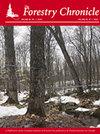东部白雪松对草甘膦的耐受性:第三年结果
IF 1.2
4区 农林科学
Q3 FORESTRY
引用次数: 0
摘要
对东白雪松(Thuja occidentalis L.)的除草剂耐受性知之甚少。为了确定雪松幼苗对除草剂施用时间和浓度的敏感性,对2岁的幼苗施用三次草甘膦(1.04、2.07和4.14酸当量(ae)kg ha-1)(7月28日、8月10日和31日),在安大略省中北部的一个研究地点。将喷洒后三年的幼苗存活率、生长和生物量与人工除草(通过人工除草消除竞争/杂草)和对照(不除草,因此总是竞争/杂草的)处理中的幼苗进行比较。仅施用4.14 ae kg ha-1的草甘膦,第三年幼苗存活率显著降低27%。雪松幼苗生长对草甘膦的敏感性表现为直径>高度。用2.07和4.14aekgha-1草甘膦处理的杉木幼苗的根系生物量显著低于对照,而只有用4.14aekgha-1草甘膦处理的雪松根系生物量低于对照。。。本文章由计算机程序翻译,如有差异,请以英文原文为准。
Glyphosate tolerance of eastern white cedar: Third year results
Little is known about the herbicide tolerance of eastern white cedar (Thuja occidentalis L.). To determine the sensitivity of cedar seedlings to timing and concentration of herbicide applications, glyphosate was applied to 2-year-old seedlings at three concentrations (1.04, 2.07, and 4.14 acid equivalent (ae) kg ha-1) at three times (July 28, August 10 and 31), at a research site in north central Ontario. Seedling survival, growth, and biomass three years after spraying were compared with those of seedlings in manual weeding (competition/weed free via manual weeding) and control (no weeding and therefore always competition/weeds) treatments. Only glyphosate applied at 4.14 ae kg ha-1 significantly reduced, by 27%, third year seedling survival. Pattern of sensitivity of cedar seedling growth to glyphosate was diameter>height. Seedlings treated with 2.07 and 4.14 ae kg ha-1 glyphosate had significantly less root biomass than those in the control plots, whereas only cedar treated with 4.14 ae kg ha-1 glyphos...
求助全文
通过发布文献求助,成功后即可免费获取论文全文。
去求助
来源期刊

Forestry Chronicle
农林科学-林学
CiteScore
1.20
自引率
0.00%
发文量
6
审稿时长
18-36 weeks
期刊介绍:
The Canadian Institute of Forestry has published The Forestry Chronicle, a professional and scientific forestry journal, since 1925. The Forestry Chronicle is published to provide information to forest practitioners about professional and scientific management of forests and their resources. The Forestry Chronicle provides forest practitioners in Canada and around the world with a means to communicate with their peers in the professional community.
 求助内容:
求助内容: 应助结果提醒方式:
应助结果提醒方式:


